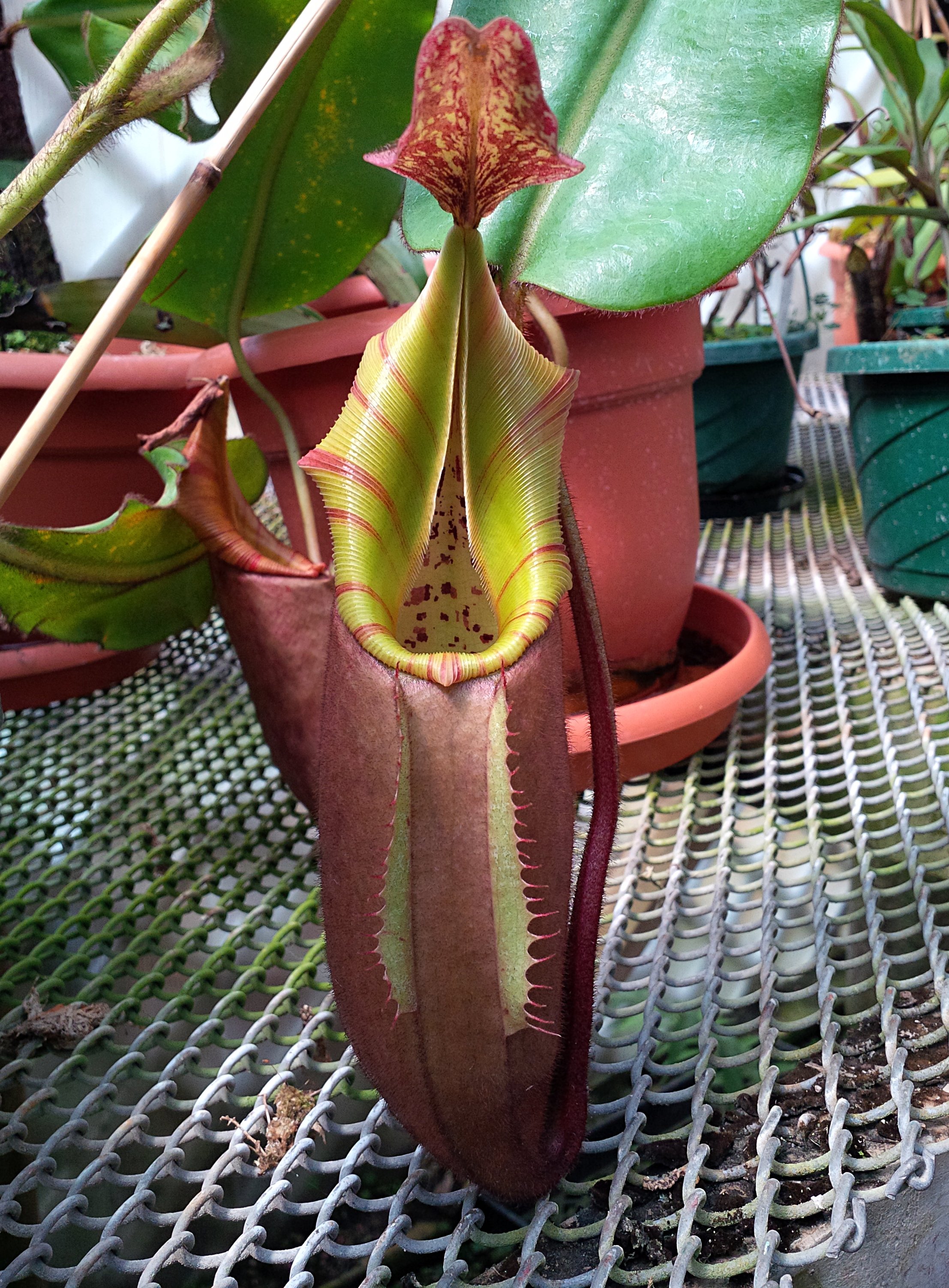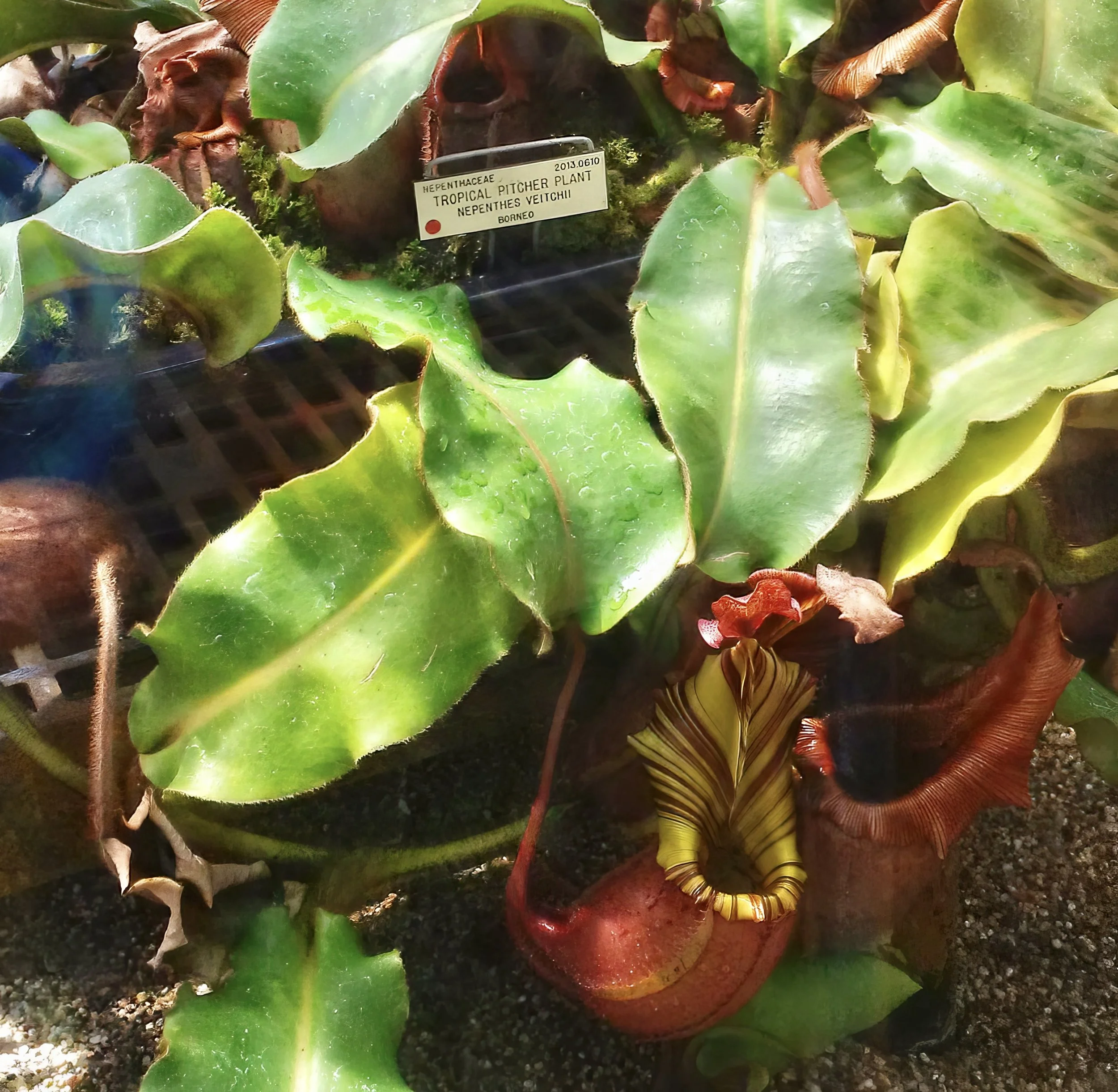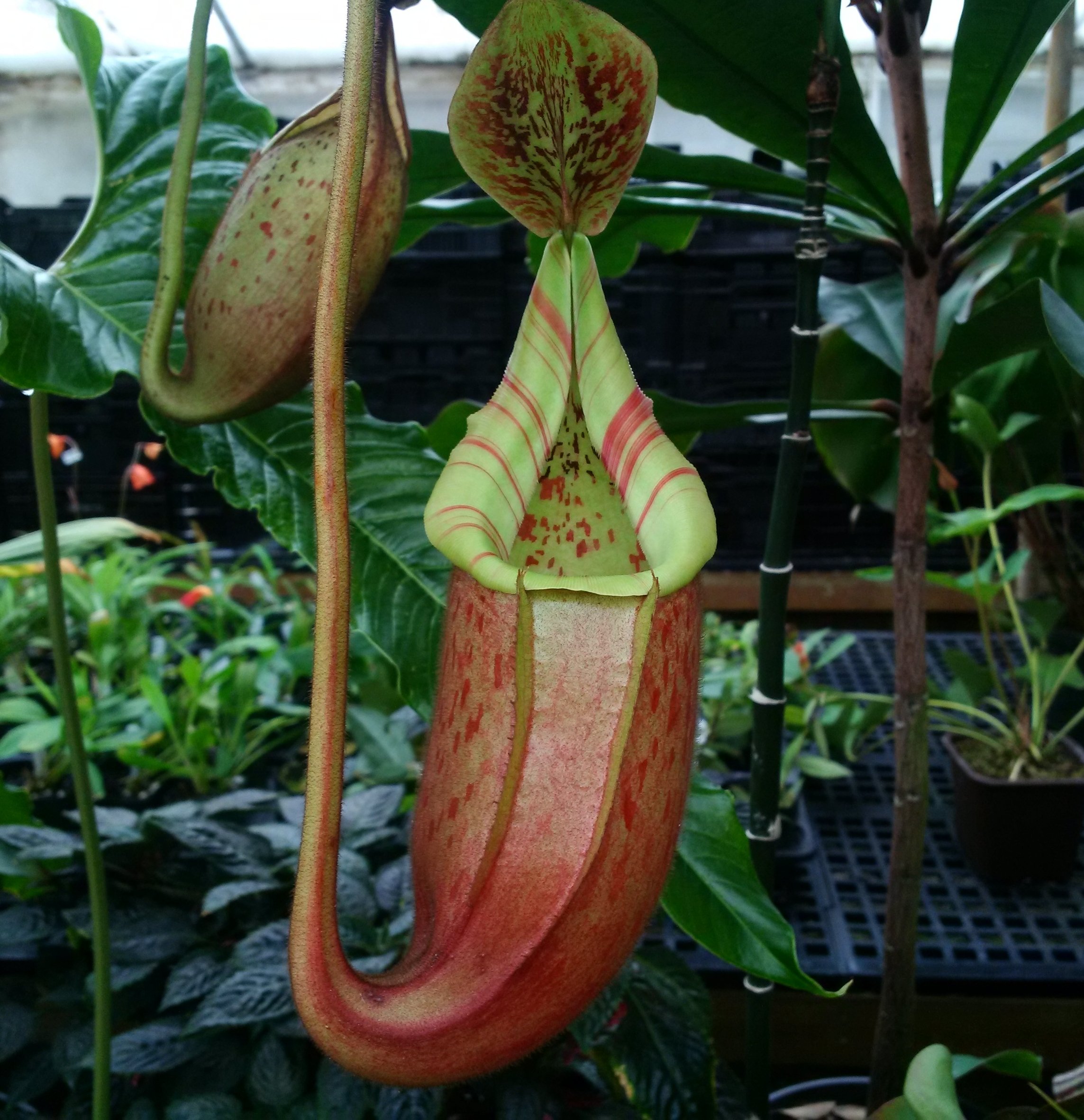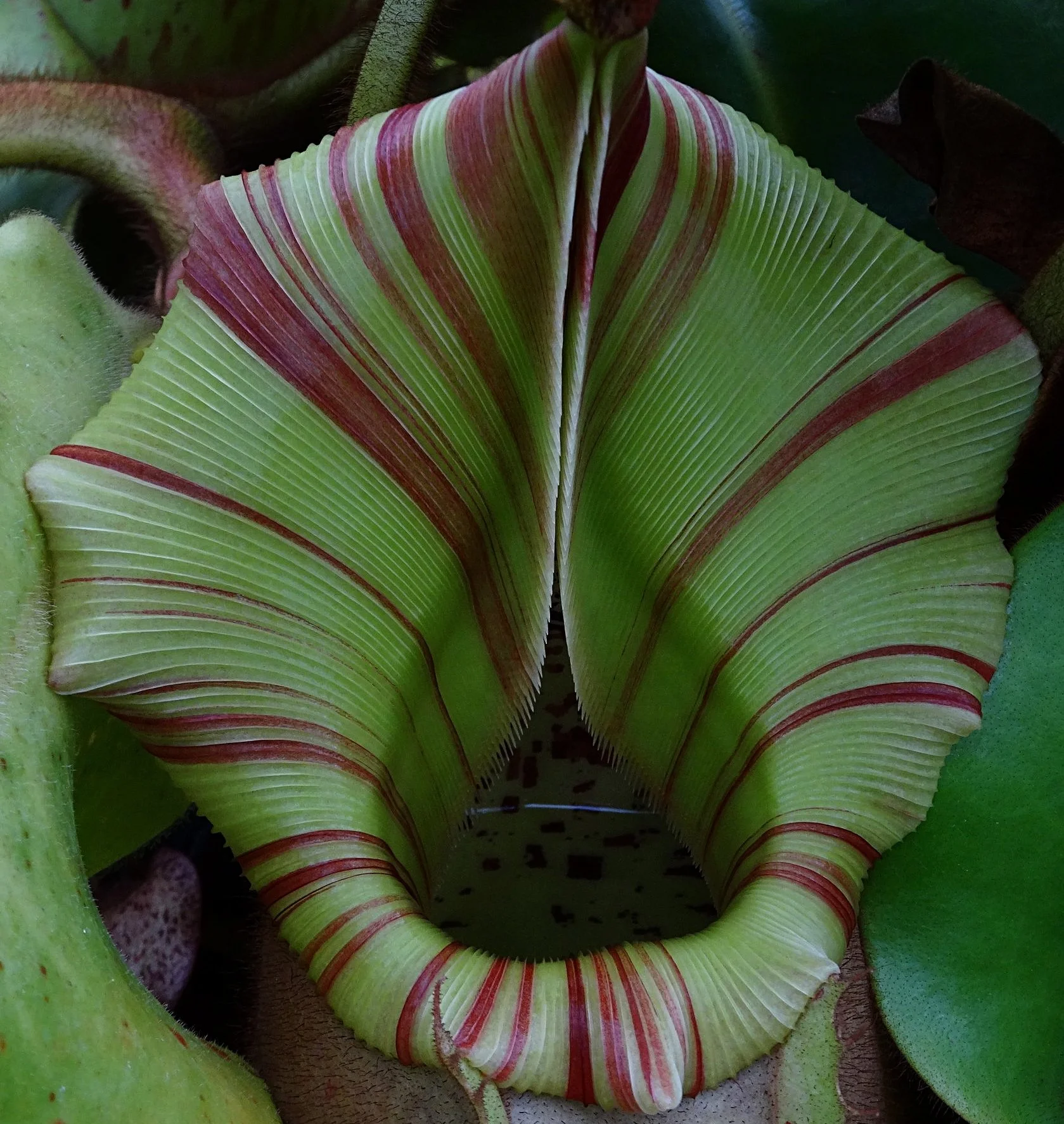Nepenthes veitchii
The Grandest Pitcher-plant ?
by Jay Vannini
Engraving of the James Veitch & Sons’ Nepenthes House in the late 19th century (Moore, “The Gardeners’ Chronicle”, March 1872)
Among the bewildering array of remarkable Nepenthes species in cultivation today, a few of the discoveries from the 19th century still stand out. The unique Bornean endemic, N. veitchii, is among the best of them. While it was discovered by Sir Hugh Low near Mount Kinabalu, the species was actually first collected by Thomas Lobb in what is modern day Sabah, Malaysia. Lobb managed to send live plants back to his employer, the James Veitch & Son nursery, in 1847. It was formally described by Sir Joseph Hooker of the Royal Botanical Gardens at Kew in 1859. This very striking tropical pitcher plant is often mentioned in books written by the British colonial administrators, naturalists and plant collectors who explored Sarawak, Brunei and Sabah later in the 19th century, most notably in Frederick Burbidge’s travelogue, “Gardens of the Sun” (1880).
Nepenthes veitchii, epiphytic form/“green peristome” being grown in Guatemala. Image: Peter Rockstroh.
Nepenthes veitchii Bario, Sarawak ecotype, normal peristome form. Grown by Josh Brown of Predatory Plants.
While quite variable in appearance, plants in cultivation appear to fall into two main forms. The most commonly seen is the scrambling/decumbent terrestrial or lithophytic form from the Sarawak lowlands that have upright, somewhat elongated/tall, dark-colored mature peristomes. Terrestrial plants with squatter, “tubby” pitchers to ~12”/30 cm tall and more widely-flared peristomes occur at forested sites throughout northeastern Sarawak, the most famous of which occurs near the community of Bario in premontane forest. Plants in this population can also vary in appearance from colony to colony, with some individuals having pink or reddish pitchers with wide, vivid, crimson-striped peristomes. The more common forms have pinkish or gold-colored peristomes that darken with age to a deep, glossy brown. The epiphytic plants from other localities have a rather different growth habit, with long, narrow triangular leaves, shorter distances between internodes and an almost radial rosette form that clambers over branches. Peristome color and form in these plants is also extremely variable between populations. They do not, as a rule, follow the terrestrial ecotypes’ models of marching steadily across a nursery bench for 6’/1.85 m or more if given enough space. There is a third plant form that appears to be endemic to the protected heath forests of the Maliau Basin and lower montane forests of Bukit Batu Lawi in southern Sabah, Malaysia. While the pitchers are typical for the species and almost identical in appearance to the terrestrial forms that occur further south, the plants have a unique climbing habit and clasp the trunks of trees with chained, interlocked pitchers as the plant climbs into the lower canopy. Exploration of adjacent heath forests in North Kalimantan, Indonesia may produce other localities that exhibit this growth habit. It is worth mentioning to novice nepenthes collectors interested in “training” their terrestrial forms up a totem that this adpressed growth habit appears to be hardwired into the Maliau Basin-Batu Lawi ecotypes, but not the others. My multiple attempts at propping a terrestrial or epiphytic ecotype up a vertical mount often produced exactly opposite of the desired result, i.e. the plant stopped growing altogether. While still somewhat rare in cultivation, Maliau Basin plants have made it into limited plant tissue culture (PTC) and as seed-grown plants in the U.S over the past years. Plants from the Batu Lawi heights have been in PTC in Germany and the Czech Republic for more than a decade, but apparently have not proven particularly popular with nepenthes collectors.
A brace of beautiful and massive pitchers on Nepenthes veitchii from the Bario, Sarawak locality. Grown by Josh Brown of Predatory Plants.
Nepenthes veitchii, lowland “Gold Peristome” form, grown in Guatemala.
Although most Nepenthes veitchii introductions from nurseries in Sri Lanka, Sarawak, Germany and Australia in the 1990s and early 2000s were rather unremarkable-looking, beginning in about 2004 seedlings of the striped peristome forms began to show up in the trade, most notably with Exotica Plants of Queensland, Australia release of young plants from what they identify as their select “(k)” cross. Older plants from the (k) series are now commonly seen in cultivation and show the expected variation of a seed-grown release, with a minority of plants showing no evidence of peristome striping throughout their lives while most others have very attractive, reddish pitchers and strongly-marked peristomes that darken with age. Note that seedlings produced from crosses involving parents with bold peristome striping and that exhibit this trait early in their development will invariably retain this feature throughout their lives, but that the absence of striping in plants up to about 4”/10 cm diameter does not necessarily mean that they won’t have banded peristomes as adults. Most striped peristomes will ultimately darken as they age. Noteworthy plants from the (k) release have been used in both sibling and hybrid crosses in California and elsewhere. Again, the presence or absence of striped peristomes with these new F2 plants varies with age and from individual to individual.
Young mature pitchers of Nepenthes veitchii (k) selections grown by the author and Peter Rockstroh in Guatemala (left - 2013) and the author in California (right - 2016) are shown above. Collectors should note that not all (k) seedlings develop reddish pitchers and peristome striping.
Nepenthes veitchii, six year-old seed-grown individual from Pa Umor, Sarawak locality. Many plants from this ecotype have pink-flecked, near globular pitchers with peristomes that remain conspicuously flared throughout the pitchers’ lives. The pitcher color on this plant has definitely improved over the past nine months with each new leaf. Some exceptional plants from this particular locality have large, bright red pitchers with widely-flared, vividly-striped peristomes. Author’s collection.
More recently, U.S. and EU based nurseries have released seed-grown plants from the Pa Umor locality, a village several miles/kilometers from Bario at about 2,760’/850 m elevation. Both Bario (located at ~3,250’1,000m) and Pa Umor plants are often referred to as “highland” forms in the trade, but the elevations that they occur at are actually better considered to be “intermediate” when compared to other parts of the Kelabit Highlands and the actual upper end of Nepenthes veitchii elevational range in nature (5,200’/1,600 m fide McPherson 2009; Clarke/IUCN 2018). The term was probably adopted to segregate these populations from plants in the nursery trade originating from Bau and other lowland localities in southern Sarawak. To confuse issues even further, some US and Czech nurseries have made crosses of different ecotypes of this species and market them as simply as “highland x lowland” for the mass market.
Recently, efforts have been made to identify and catalogue the origins of many of the Nepenthes veitchii clones in PTC by the Italian nepenthes researcher Marcello Catalano as well as others. Since the nepenthes flora of Borneo is by no means a closed book, serious collectors should make every effort to attach bona fide locality data to their plants for future reference, whether from PTC or seed origin.
Two very different-looking Nepenthes veitchii originating from the Bario, Sarawak locality are shown above. Both are exceptional and well-cultivated specimen plants with very large pitchers for this species. Grown by Josh Brown of Predatory Plants.
Four and one half year-old seed-grown Nepenthes veitchii (k) plantlets in my collection in California. These plantlets are from a select F1 intracross made by Drew Martinez and are growing in a 6”/15 cm diameter hanging compot. This is approximately the size (3-4”/7-10 cm) when seedlings of this species finally take off.
This species is straightforward and easy to grow in cultivation. The Bario origin plants in particular seem quite tolerant of a wide range of temperatures from the mid-40s F/7.5 C to 95 F/35 C during the summer. Preferred range appears to be between ~55 F/13 C degrees at night with daytime highs of ~85 F/30 C degrees. Humidity should be uniformly high for the production of lush, clean leaves and full-sized pitchers. Plants grown very bright tend to have very tight foliar clusters with minor red-spotting when compared to shade grown plants. Leaves are usually square or rectangular in the terrestrial forms, and narrow-triangular in epiphytic ecotypes. Leaves, stems and pitchers are all covered with a dense reddish indumentum, with some plants looking positively “furry” when young. I have grown plants to specimen size in Guatemala and California is both conifer bark-based + pumice mixes and pure NZ sphagnum moss. Seedlings seem painfully slow to get going during the first five years, but older, established plants can be surprisingly fast-growing and very tolerant of occasional stem and offset removals for propagation purposes.
I have cultivated many of the forms that have made it to commercial release to respectable sizes over the past 20 years, both from PTC and from seed sources produced by all the major non-U.S. nurseries. I have also seen almost every form in general cultivation. Currently I have just over half a dozen seed-grown plants of the so-called “candycane-striped” peristome forms from both Bario and Pa Umor localities growing in my personal collection in a cool tropical California
Nepenthes veitchii, epiphytic form, “pink peristome”. This particular clone shows exceptionally high color when opening, but loses its bright colors as the pitchers age. Grown by Josh Brown of Predatory Plants.
Given that there are large numbers of exceptionally-colored N. veitchii from the Kelabit Highlands region now in the hands of nurserymen around the world, it should come as no surprise that improved selections are making their way to market at an ever-increasing pace. The terrestrial and epiphytic forms are very collectible plants that – while occupying a bit of bench space as adults – offer an advantage over other Nepenthes species that will rapidly scramble up into and dominate their grow areas. While probably not as coveted by most nepenthes growers as N. edwardsiana, exceptional, well-grown “candycane-striped” clones of this species can be among the choicest and most expensive tropical pitcher plants currently on the market. Many experienced carnivorous plant growers consider this species one of their favorite nepenthes.
Charles Clarke (1997) and others have documented natural hybrids between Nepenthe veitchii and N. stenophylla at localities in both Sabah and Sarawak. Some nepenthes growers and Malaysian botanists also believe that the vividly-marked epiphyte, N. hurrelliana, may hybridize with N. veitchii at localities where they occur in relative proximity. German nurseryman Christian Klein released this combination as a man-made hybrid some years back. An earlier guide to Malaysian pitcher plants than Clarke’s Borneo monograph, Phillips and Lamb (1988), discussed and illustrated what was to become N. hurrelliana (= N. mollis?) as a natural hybrid between N. veitchii and N. fusca. Some eight years later they accepted that it was indeed a novel species that was finally described and published in 2003 by Cheek, et.al. There is ongoing debate among both armchair naturalists in the U.S. and fieldworkers in Borneo as to whether N. fusca and N. veitchii intergrade in nature to form stable populations of N. hurrelliana.
A strikingly-colored Nepenthes veitchii originally from the late SF Bay Area collector Geoffrey Wong behind glass at UC Berkeley BG. Apparently still in its original bonsai tray.
A stunning pair of N. x Tiveyi intermediate pitchers. Grown by Josh Brown of Predatory Plants.
Nepenthes veitchii has proven very popular with hybridizers since the late 19th century when George Tivey of Veitch’s crossed this species with N. maxima as the seed parent (listed as Curtisii var. superba) to create N. x Tiveyi, a beautiful and enduring hybrid that has been remade on many occasions since its original introduction in 1897. As the photo shown here demonstrates, the better clones of Tiveyi have few equals among modern hybrids and its superb traits have also been further transferred to complex hybrids made over the past several decades. In 2015, one of my plants, a female (k), flowered and was selected to create a very vigorous hybrid together with a nice N. mira as the pollen parent. Seedlings from this cross have been released by Predatory Plants as N. Velvet Mirror. A number have now grown to respectable sizes and show great promise in cultivation, blending the better characteristics of both parents well but are faster-growing than either. Evenly-balanced “blending” appears to be a reliable characteristic of primary crosses involving N. veitchii. Other notable modern hybrids of N. veitchii matched to desirable species include N. veitchii “Highland” x burbidgeae (and the reverse cross), N. veitchii x platychila, N. veitchii x lowii, N. veitchii x hurrelliana and N. spectabilis “Giant” x veitchii. When candy-striped peristome N. veitchii have been used in crosses, it appears to be a persistent trait into F2 and F3 hybrids (see example in complex cross shown at the bottom of this post).
Large lower and intermediate pitchers on the primary hybrid, Nepenthes veitchii HL x burbidgeae from EP. Both parents showing off some of their nicer traits in this beautiful cool-growing hybrid. Author’s collection.
Nepenthes veitchii is a pitcher plant species whose popularity among tropical plant collectors has only increased since its discovery more than 170 years ago. This is indeed, “…one of the grandest Pitcher-plants in cultivation…”
Above left, one of my select Nepenthes veitchii (k) x mira, N. Velvet Mirror ‘Lipstick’ plant at 28 months of age and >20”/50 cm in diameter (!!). Conspicuous red midveins are frequent in this grex and, together with flared and striped peristomes in many individuals, are derived from the N. veitchii seed parent. Right, a 15”/38 cm tall mature upper pitcher on the complex hybrid Nepenthes lowii x (northiana x veitchii) in a California greenhouse. Note the width and intensity of peristome striping derived from the northiana and veitchii grandparents and the underlid bristles from the N. lowii seed parent. Both plants in the author’s collection.
All content ©Exotica Esoterica LLC® 2018-2025 and ©Jay Vannini 2018.
Follow us on:











